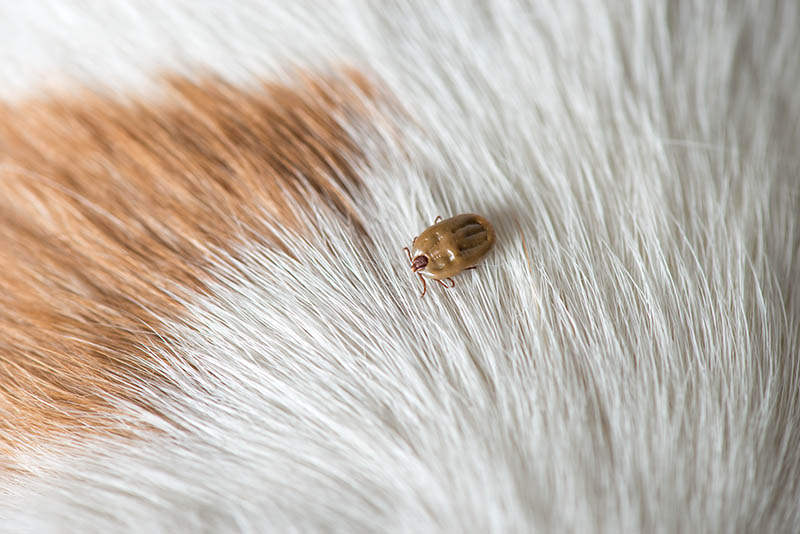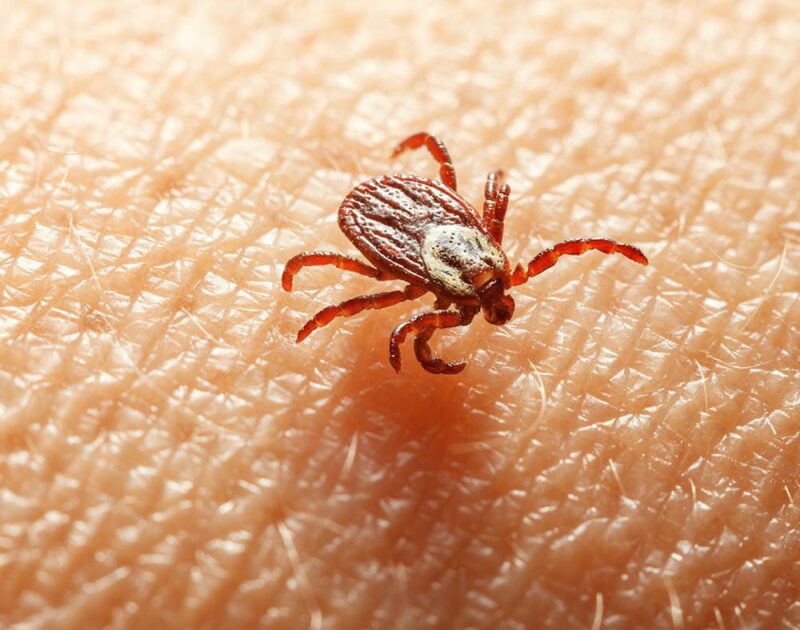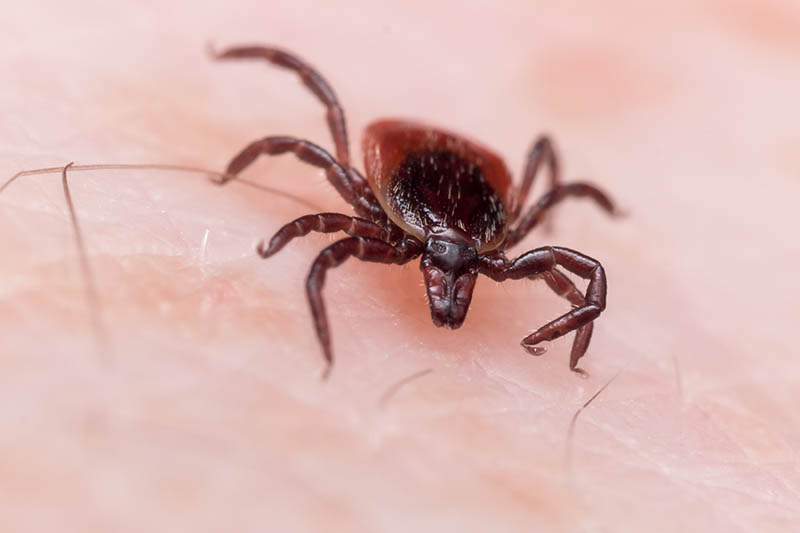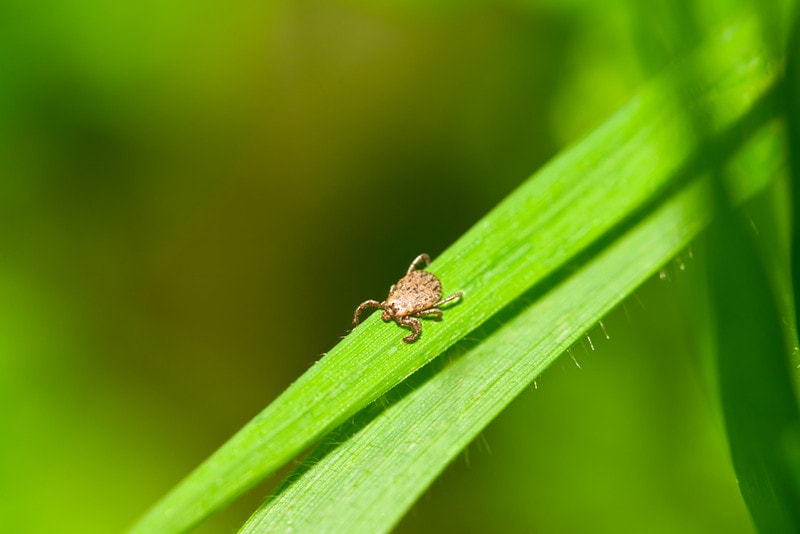7 Types of Ticks in Oregon (With Pictures)
-
Pete Ortiz
- Last updated:

Ticks are blooding-sucking parasites that human beings and animals detest. They can make your life and that of your animals difficult if they invade your home. These pests undergo three life cycle stages: eggs, the larval stage, nymph, and adult ticks that are lethal in sucking blood. Larval and nymph stage ticks can also bite and suck blood, although their small size makes them unnoticed if one clings onto your skin.
There are over 20 types of tick species in Oregon State alone, and this number is even more across the fifty states in the US and every continent globally, including Antarctica. These parasites live in animal and human blood. Let’s check out a list of some of the most commonly seen ticks in Oregon.
The 7 Types of Ticks in Oregon
1. Rocky Mountain Wood Tick

The Rocky Mountain Ticks almost resemble American dog ticks. You can identify these ticks with their red-brown legs and relatively dark-brown bodies. The ticks also have small mouthparts with narrow and pear-shaped bodies.
Male Rock Mountain ticks are characterized by a tan mottling across the abdomens, while females only have a tan on the scutum.
- Bright reddish teardrop-shaped bodies
- Adult males have white and gray spots
- Females have a white shield
You will mostly find these ticks in the higher habitat of Oregon State, including grasslands, shrublands, meadows, and trails. The ticks love elevations of over 4,000 feet and are primarily active during spring and fall.
These ticks hide in low-growing vegetation, grassland, and trails, waiting for their hosts to pass. The larvae and nymphs of these ticks feed on the blood of small animals and rodents, as adult ticks feast on human beings and other mammals’ blood.
2. American Dog Tick

The American Dog tick is the largest known tick in Oregon State. These ticks have red-brown legs and bodies like most Rocky Mountain Wood Ticks. The adult males are more mottled, while a female has an off-white dorsal shield (scutum).
These ticks have an oval shape with white-gray markings. They use three different hosts in their life cycle, and they feed on various animals ranging from small-sized rodents to big livestock. Adult American dog ticks like medium-sized hosts such as skunks, raccoons, dogs, and cats, among other canids. The ticks also infest coyotes, cattle, horses, and people. They are the primary vectors for the spread of Rocky Mountain spotted fever.
- They transmit Tularemia, and Rocky Mountain spotted fever
- They can survive for up to 2 years without feeding
- Adults don’t transmit infections
- They are slow feeders
3. Winter Tick
The Winter Ticks rarely bite people. The adult ones are characterized by tiny mouthparts and brown bodies that can elongate to ¾ when full of blood from their hosts. Females have dark brown bodies and tan scuta, while their male counterparts have tan with brown patterns on the abdomen.
These ticks suck blood from large mammals such as deer, elk, and moose. Animal victims may succumb to anemia due to severe infestations from winter ticks. The moose are more vulnerable to severe infestation because of their poor grooming nature. Statistics show that a single moose can have as many as 100,000 winter ticks¹ in a season.
Unlike most other tick species, Winter Ticks are mainly active during winter and fall. These are not associated with Rocky Mountain spotted fever or Lyme transmission.
4. Brown Dog Tick

The Brown Dog Tick¹, scientifically known as Rhipicephalus sanguineus, is one of the most widespread ticks in Oregon and globally. These ticks are prevalent in warm climates where they infest dogs, houses, kennels, and wildlife, but dogs are the tick’s favorite hosts.
- Male, females, and nymphs are reddish-brown with elongated body shapes
- Females take large blood meals while males suck small portions
- The tick’s larvae have three pairs of legs with body dimensions of about 0.54 mm and 0.39 mm in length and width, respectively
- Nymphs can grow to 1.14–1.30 mm and 0.57–0.66 mm in length and width, respectively
- The female’s body size increases a hundredfold during feeding
The brown ticks differ from other ticks in Oregon because they can complete their life cycle indoors, making these species widespread mainly in homes. However, they don’t bite humans. All the same, they are known carriers of the bacterium causing Rock Mountain spotted fever. They must attach to the host and suck blood for at least six hours for transmission.
These ticks can also transmit diseases such as Canine Babesiosis and Canine Ehrlichiosis to dogs. It’s advisable to take your tick-infested dog to a veterinarian as soon as you notice odd symptoms.
5. Soft Ticks

Soft Ticks are anatomically different from hard ticks because the former lacks the rigid outer shield, also known as a scutum. These ticks have more wrinkled-looking bodies, and their mouthparts are located underside the body, hidden from view. A summary of identifying characteristics includes:
- Soft and more rounded bodies without elaborate external jaws
- The ticks vary in size significantly, but adult males and females are almost the same sizes
- Their mouthparts aren’t visible like most ticks
- They feed mainly at night
There are at least 193 known species of soft ticks¹, all of which exhibit distinct behavioral patterns. These ticks encompass the entire Argasidae family, and they live in Oregon’s hot and dry areas. Their typical habitat includes caves, dens, animal burrows, and human dwellings. They are rarely found in natural vegetation.
Soft Ticks are blood vampires-they feed on hosts as they sleep, unlike other ticks that wait for hosts to walk by. They have a painless bite making most bites go unnoticed- they can feed within one hour. This type is associated with tick-borne relapsing fever.
6. Western Blacklegged Tick/ Western Deer Ticks

The Western Blacklegged Tick, scientifically known as Ixodes pacificus, is another common blood-sucking parasite in Oregon State. These ticks are prevalent in deciduous forests and shrubbery forest edges. It’s rare to spot them in grasslands or open fields.
- Adult females have a black and brown back with orange-brown abdomens
- Adult males are brownish-black and oval-shaped
- The females’ mouthparts stick out more than the males
These ticks are more active in winter and early summer as decreasing humidity curtails their activities. The nymphs are abundant between April and June.
The Western Blacklegged Ticks are found mainly on rodents, humans, and other mammals. Immature stages feed on small animals such as lizards and rodents, including larvae and nymphs.
Male ticks in these species don’t transmit diseases. Common diseases that females transmit include Lyme, Ehrlichiosis, Anaplasmosis, and Powassan Virus.
7. Pacific Coast Tick

The Pacific Coast Tick, known as Dermacentor occidentalis, is a human-biting tick found in Oregon. These ticks have a broad host range in the thicket and shrub lands and trails of Oregon to California’s northern Baja and Mexico.
- Adult males are speckled brown
- Females have a dark reddish-brown color with black and creamy white shields
Adult male and female Pacific Coast Ticks are active throughout the year, although their peak period is in the cooler months, mainly in April and May. Adult ticks feast on larger mammals such as horses, cattle, and deer but can also attack pets and humans. The larvae and nymphs rarely attack pets or humans.
The male ticks attach to the hosts and feed for short periods to initiate the production of sperm. On the other hand, females feed for an average of six to ten days before detaching from the hosts to lay eggs.
Approximately 11% of adult Pacific Coast ticks are carriers of Rickettsia Phillippi¹. This germ is responsible for forming the cutaneous lesion (Eschar).
How Can You Avoid Ticks in Oregon?
Ticks are a problem in Oregon and the United States in general because they transmit diseases. The CDC estimates that about 300,000 people¹ contract Lyme annually in the US, making it vital to avoid these parasites.
Your first step to avoiding tick bites is wearing long-sleeved shirts, long trousers, and closed shoes. As you step out, avoid tall grasses and thickly wooded areas with heavy foliage that might brush against you. If you can’t avoid such areas, you can wear light-colored clothes so that you can spot a tick crawling on you easily.
Get home and shower instantly after exploring nature or hiking. Pay attention to your body, especially hair, armpits, crotch, and other skin fold areas that may hide ticks. Check your furry pets to ensure that nobody is bringing undesirable and blood-sucking guests into your home.
At home, ensure that you mow grass in your yard and eliminate all trash and old furniture to keep your yard clean. Use bug repellants specified to repel ticks. Follow the manufacturer’s guidelines as not all repellents are meant for ticks.
Conclusion
Ticks are common disease-transmitting parasites in Oregon. It’s essential to perform regular checks to ensure your living space is free from ticks to safeguard your family, pets, and domestic livestock.
The above list offers insights into the types of ticks prevalent in Oregon, the associated diseases, and how to avoid them.
Featured Image Credit: antpkr, Shutterstock
Contents



